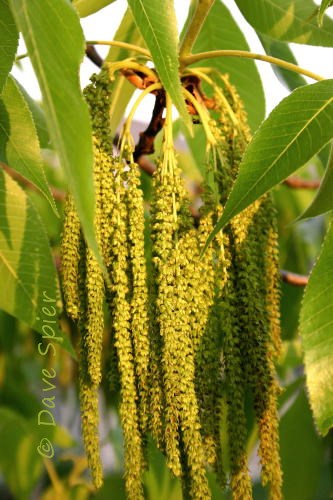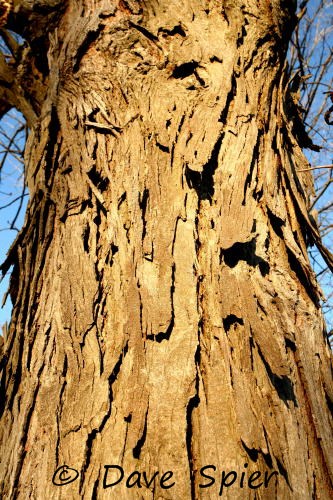 |
| emerging hickory leaves can sometimes resemble praying hands |
© Dave Spier
 |
| young hickory leaves unfolded and growing |
 |
| hickory flowers are wind pollinated |
Shagbarks, aptly named for the long, peeling shreds of bark, can easily grow to a height of 60 to 90 feet. The record is 120 feet. The wood is strong and elastic and was once prized for tool handles, gunstocks, skis and chair backs. When burned, it gives off a lot of heat and makes high-grade charcoal.
 |
| Shagbark Hickory bark |
In late summer and early fall, the thick-walled nut husks split into four sections and release the four-ridged nuts which are good to eat. (Squirrels, possums, Wild Turkeys and Wood Ducks would agree.) The nuts also can be ground in a meal-like flour or crushed and boiled to separate the oil. Rabbits and deer browse the twigs. In late winter, the trunks can be tapped in the manner of collecting maple sap.
 |
| child holding hickory nuts, some with the husk on (Bayberry Environmental Education Center, Junius, NY, when I was a naturalist there) |
Hickories are related to walnuts and butternuts (Juglans spp.) which have numerous leaflets, all roughly the same size. All these trees are in the same family (Juglandaceae) along with pecans.
Corrections, comments and questions are always welcome at northeastnaturalist@yahoo.com or connect through my Facebook page and photo page. There's also a community-type page for The Northeast Naturalist. Other nature and geology topics can be found on the parallel blogs Adirondack Naturalist and Heading Out.
No comments:
Post a Comment